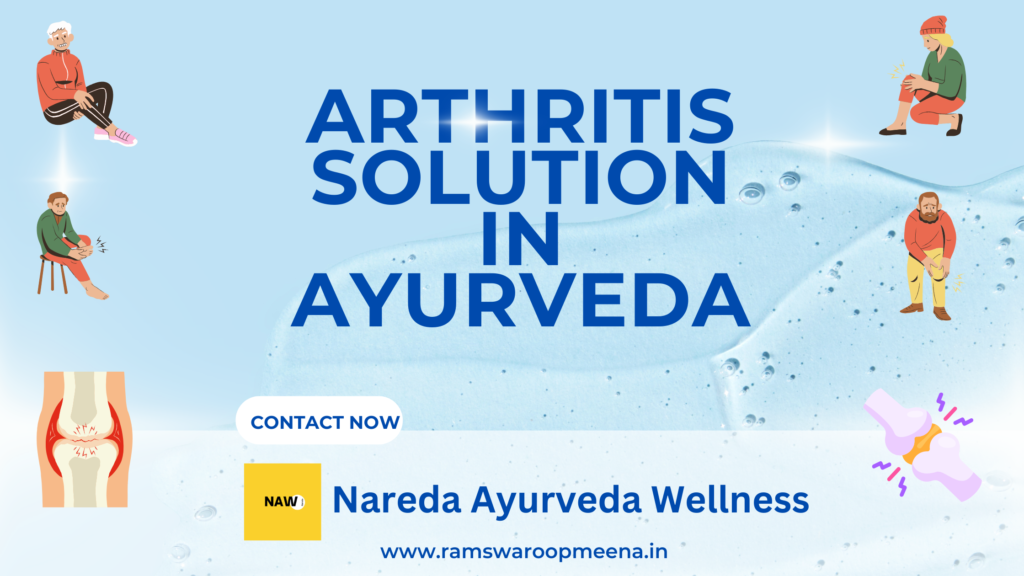7 Best Tips for Arthritis Treatment in Ayurveda

Arthritis is a condition characterized by inflammation in the joints, leading to pain, stiffness, swelling, and restricted mobility. With over 100 types of arthritis, the most common forms include osteoarthritis and rheumatoid arthritis. While modern medicine offers various treatments, including painkillers, anti-inflammatory drugs, and even surgery in severe cases, these approaches often focus on symptom management rather than long-term healing.
Ayurveda, the ancient system of natural healing that has been practiced in India for over 5,000 years, offers a holistic approach to treating arthritis. The Ayurveda approach seeks to balance the body’s doshas (Vata, Pitta, and Kapha) to restore harmony and treat diseases at their root cause. Ayurvedic treatments for arthritis include dietary changes, herbal remedies, therapies, and lifestyle modifications, all aimed at reducing inflammation and improving joint health.
In this blog, we will explore the 7 best Ayurvedic tips for treating arthritis. These tips focus on both alleviating the symptoms of arthritis and promoting long-term joint health.
1. Balancing Vata Dosha
In Ayurveda, arthritis is primarily associated with an imbalance in the Vata dosha, which governs movement and flow in the body. When Vata becomes aggravated, it can lead to dryness, cracking, and discomfort in the joints, which are common symptoms of arthritis.
How to balance Vata:
- Warmth: Keeping the body warm is essential for balancing Vata. Avoid exposure to cold weather, cold food, and cold environments as they can aggravate Vata and worsen arthritis symptoms. Opt for warm clothes and use heating pads or warm baths to soothe stiff joints.
- Oil Massage (Abhyanga): Regular oil massage with warming and lubricating oils like sesame or castor oil can help soothe Vata and improve joint flexibility. The massage should be done gently in circular motions, especially around affected joints.
- Diet: A Vata-balancing diet is key to managing arthritis. Favor warm, moist, and easy-to-digest foods like cooked vegetables, soups, and stews. Avoid dry, cold, or raw foods that can aggravate Vata. Incorporating ghee (clarified butter) and healthy oils in your diet can also help lubricate joints from the inside.
- Herbal Remedies: Ayurvedic herbs such as ashwagandha, shatavari, and bala are known for their ability to balance Vata dosha and provide relief from arthritis pain and inflammation.
Why this helps:
Balancing Vata dosha is a fundamental step in Ayurvedic treatment for arthritis because it addresses the root cause of joint dryness, stiffness, and pain. By incorporating warmth, lubrication, and a nourishing diet, this approach helps calm Vata and promote overall joint health.
2. Herbal Supplements
Ayurveda relies heavily on the use of herbs to treat arthritis. Several powerful Ayurvedic herbs have anti-inflammatory, analgesic, and rejuvenating properties that can help manage arthritis symptoms and improve joint function.
Key Ayurvedic Herbs for Arthritis:
- Ashwagandha: Known as an adaptogen, ashwagandha helps reduce inflammation, alleviate pain, and strengthen the joints. It also supports the immune system and enhances overall vitality.
- Turmeric (Curcumin): Turmeric is a potent anti-inflammatory herb that is widely recognized for its ability to reduce swelling and pain in arthritis. Curcumin, the active compound in turmeric, inhibits inflammatory pathways and offers long-term relief from joint pain.
- Guggul: Guggul is a resin derived from the Commiphora mukul tree and is often used in Ayurveda to treat arthritis. It helps reduce joint inflammation, improve mobility, and protect cartilage.
- Boswellia (Indian Frankincense): Boswellia is another effective herb for reducing inflammation in arthritis. It blocks leukotrienes, which are responsible for inflammation and can cause joint damage in conditions like rheumatoid arthritis.
- Triphala: A combination of three fruits (Amalaki, Bibhitaki, and Haritaki), Triphala acts as a detoxifying agent and can improve digestion and immunity, both of which are important for overall joint health.
How to Use:
These herbs can be consumed in the form of powders, capsules, or teas. Ayurvedic practitioners often recommend specific formulations based on the individual’s dosha imbalance and the severity of their arthritis.
Why this helps:
Herbal remedies in Ayurveda not only provide relief from the symptoms of arthritis but also promote healing at the cellular level. By reducing inflammation, improving circulation, and nourishing the tissues, these herbs work to rejuvenate and strengthen the joints over time.
3. Detoxification (Panchakarma)
Panchakarma is one of the most effective treatments in Ayurveda for eliminating toxins (ama) from the body, which are believed to be the root cause of many diseases, including arthritis. Panchakarma involves a series of detoxifying therapies that cleanse the body of accumulated toxins and restore balance to the doshas.
Key Panchakarma Therapies for Arthritis:
- Abhyanga: A full-body oil massage using medicated oils helps loosen toxins and prepare the body for further detoxification.
- Swedana: This therapy involves herbal steam treatments to open up the channels, promote sweating, and help the body release toxins through the skin.
- Basti (Medicated Enemas): Basti therapy is particularly effective for treating Vata-related disorders like arthritis. Medicated oils or herbal decoctions are introduced into the colon to nourish the tissues, remove toxins, and reduce inflammation.
- Virechana (Purgation): This is a controlled purgation therapy using herbal laxatives to cleanse the digestive system and remove toxins from the liver and gallbladder.
Why this helps:
Detoxification is a critical part of Ayurvedic arthritis treatment as it helps remove ama, the toxic byproduct of poor digestion and lifestyle habits. Once the body is cleansed, it becomes more receptive to healing and the effects of herbal remedies, dietary changes, and other treatments.
4. Anti-inflammatory Diet
In Ayurveda, a balanced diet plays a crucial role in managing arthritis. The primary focus is on avoiding foods that aggravate Vata dosha and lead to inflammation in the body.
Foods to Include:
- Ghee and Oils: Healthy fats like ghee and sesame oil lubricate the joints and reduce dryness.
- Ginger and Garlic: Both ginger and garlic have anti-inflammatory properties and can help alleviate joint pain.
- Leafy Greens: Cooked leafy greens like spinach and kale are rich in vitamins and minerals that support joint health.
- Whole Grains: Warm, cooked grains like quinoa, rice, and oats help stabilize Vata and reduce inflammation.
- Omega-3 Rich Foods: Flaxseeds, chia seeds, and walnuts are excellent sources of omega-3 fatty acids, which have anti-inflammatory effects.
Foods to Avoid:
- Cold and Raw Foods: These can aggravate Vata and contribute to joint stiffness and discomfort.
- Processed Foods: Foods high in preservatives, artificial additives, and sugars increase inflammation and should be avoided.
- Nightshades: Vegetables like tomatoes, potatoes, and bell peppers can worsen inflammation for some people with arthritis.
- Excessive Caffeine and Alcohol: Both can dehydrate the body and exacerbate Vata imbalance.
Why this helps:
A well-balanced, anti-inflammatory diet is essential for managing arthritis symptoms. By nourishing the body with the right foods and avoiding inflammatory triggers, you can significantly reduce joint pain and swelling.
5. Yoga and Pranayama
Exercise is a critical part of managing arthritis, but not all forms of exercise are suitable for people with joint pain. Yoga, with its gentle stretches and focus on flexibility, is an ideal form of physical activity for arthritis patients. It improves circulation, strengthens muscles around the joints, and enhances flexibility.
Key Yoga Poses for Arthritis:
- Tadasana (Mountain Pose): Improves posture and strengthens the legs and spine.
- Vrikshasana (Tree Pose): Enhances balance and strengthens the lower body.
- Bhujangasana (Cobra Pose): Stretches the spine and strengthens the back muscles, which is important for overall joint health.
- Shavasana (Corpse Pose): This relaxation pose helps calm the mind and relieve stress, which can exacerbate arthritis symptoms.
Pranayama (Breathing Exercises):
- Nadi Shodhana (Alternate Nostril Breathing): Helps balance the doshas, calm the mind, and reduce stress, which can aggravate arthritis.
- Ujjayi Breathing: This slow and controlled breathing technique helps increase oxygen flow and reduce inflammation in the body.
Why this helps:
Yoga and pranayama not only improve joint flexibility and strength but also help calm the mind and reduce stress. Since stress is known to exacerbate arthritis symptoms, these practices provide both physical and emotional relief.
6. Hydrotherapy
Water therapy or hydrotherapy is another effective way to soothe arthritic joints. Warm water helps relax muscles, reduce joint stiffness, and improve blood circulation, making it easier to move without pain.
Hydrotherapy Options:
- Warm Baths: Soaking in a warm bath, especially with Epsom salts or Ayurvedic herbs like dashamool, can help relax the joints and ease pain.
- Contrast Hydrotherapy: This involves alternating between warm and cold water to stimulate circulation and reduce inflammation.
- Swimming: Swimming in warm water is a low-impact exercise that is excellent for arthritis patients. It helps strengthen muscles around the joints without putting undue pressure on them.
Why this helps:
Hydrotherapy offers immediate relief from arthritis symptoms by reducing pain, inflammation, and stiffness. The buoyancy of water also reduces the stress on joints, making it easier to exercise and stay active.
7. Lifestyle Changes
In Ayurveda, leading a balanced and mindful lifestyle is key to managing any chronic condition, including arthritis. This includes regular sleep patterns, stress management, and daily routines (dinacharya) that support overall health.
Key Lifestyle Tips:
- Adequate Rest: Ensure you get 7-8 hours of restful sleep every night. Poor sleep can worsen inflammation and joint pain.
- Stress Management: Chronic stress can exacerbate arthritis symptoms. Incorporating relaxation techniques like meditation, deep breathing, or journaling into your daily routine can help.
- Daily Routine: Following a consistent daily routine, including regular meal times, exercise, and sleep, helps balance the doshas and supports joint health.
- Avoid Excessive Physical Strain: While regular exercise is important, it’s equally important to avoid overexertion, which can strain the joints and lead to more pain.
Why this helps:
Ayurveda emphasizes balance in all aspects of life. A healthy, consistent lifestyle helps keep the doshas balanced, reduces the production of toxins, and supports the body’s natural healing processes.
Conclusion
Ayurveda offers a holistic and natural approach to treating arthritis by addressing the root cause of the condition rather than just the symptoms. By balancing the Vata dosha, incorporating herbal remedies, detoxifying the body, following an anti-inflammatory diet, practicing yoga and pranayama, using hydrotherapy, and making lifestyle changes, arthritis sufferers can experience significant relief from pain and inflammation.
Unlike conventional treatments that often rely on medications, Ayurveda provides long-term solutions that promote overall health and well-being. It focuses on balancing the body’s natural systems, allowing for a more sustainable and effective approach to managing arthritis. If you’re considering Ayurvedic treatment for arthritis, consult an Ayurvedic practitioner to personalize your treatment plan based on your specific needs and dosha imbalances.
Incorporating these 7 Ayurvedic tips can greatly improve your quality of life, reduce arthritis symptoms, and restore joint health naturally.

Pingback: आर्थराइटिस के लिए 7 शक्तिशाली और प्राकृतिक आयुर्वेदिक उपचार